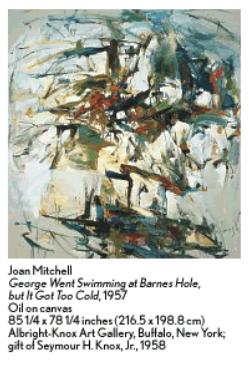The Paintings of Joan Mitchell
dal 20/9/2003 al 4/1/2004
Segnalato da
20/9/2003
The Paintings of Joan Mitchell
Modern Art Museum of Fort Worth, Fort Worth
The work of Joan Mitchell (1926–1992), whose highly charged, emotionally expressive paintings are among the most radiant works of postwar American art is the subject of this comprehensive retrospective. This exhibition brings together nearly fifty paintings showcasing her work as one of the top rank of American Abstract Expressionists

The work of Joan Mitchell (1926–1992), whose highly charged, emotionally expressive paintings are among the most radiant works of postwar American art is the subject of the comprehensive retrospective, The Paintings of Joan Mitchell. This exhibition brings together nearly fifty paintings showcasing her work as one of the top rank of American Abstract Expressionists.
Mitchell studied art in her native city at The Art Institute of Chicago, where she became an adept draftsman and skilled representational painter. She moved to New York City in the late 1940s, just as such Abstract Expressionists as Willem de Kooning and Franz Kline were making their impact on the New York art world. Their rejection of recognizable imagery, emphasizing color and bold brushwork to carry their meaning, ignited Mitchell’s passion. She determined to make a career as an abstract artist, quickly joining their professional and social milieu.
Within a few years Mitchell had developed a signature style characterized by brush handling that combined vigor with delicate subtlety. She also began to use gravity to create drips, or runs, of paint that both enlivened and anchored the pictorial space. Her movement into a fully original abstract style progressed with such rapidity that fellow artists and critics alike remarked on it with envy and admiration.
Joan Mitchell If there is an underlying reference to the world in Mitchell’s art, it is to landscape. Bridges, trees, and the shimmering effects of water constitute her most enduring themes. Remaining true to abstraction, Mitchell achieved a synthesis between the allover composition often identified with Abstract Expressionism, and an emergent figure-and-background relationship. Mitchell also proved to be a gifted colorist, restlessly experimenting with a lush and variegated palette.
The most significant change in Mitchell’s work occurred when she moved, in 1969, from Paris to Vétheuil, near the former home and garden of the French Impressionist painter Claude Monet. Her scale increased, her spatial structure became more deliberate, and color became the dominant subject matter. For the rest of her life, Mitchell would take her inspiration from long views over the River Seine and the majestic trees and cultivated fields surrounding her studio.
The Paintings of Joan Mitchell is supported by The Florence Gould Foundation, the National Endowment for the Arts, Andrea and James Gordon, the Dedalus Foundation, Inc., and Elise Jaffe and Jeffrey Brown.
This exhibition was organized by Jane Livingston, Yvette Y. Lee and the Whitney Museum of American Art, New York. Promotional support for the Modern Art Museum of Fort Worth provided by the Fort Worth Star-Telegram and Authentic Press. Air transportation provided by American Airlines.
Related events
September 23, 2003, 7 pm, Tuesday Evening Lecture
Jane Livingston
Joan Mitchell: Painter and Person
The Modern Art Museum of Fort Worth is located at 3200 Darnell Street.



